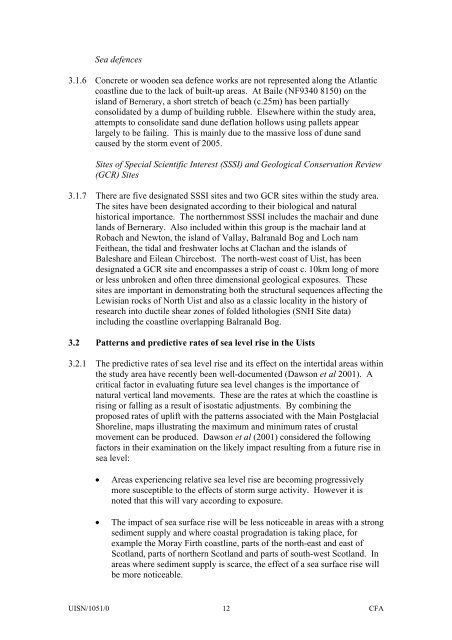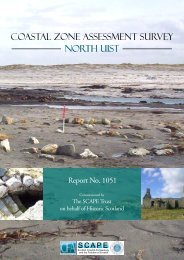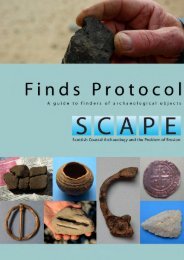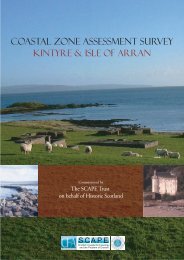download - SCAPE
download - SCAPE
download - SCAPE
Create successful ePaper yourself
Turn your PDF publications into a flip-book with our unique Google optimized e-Paper software.
Sea defences<br />
3.1.6 Concrete or wooden sea defence works are not represented along the Atlantic<br />
coastline due to the lack of built-up areas. At Baile (NF9340 8150) on the<br />
island of Bernerary, a short stretch of beach (c.25m) has been partially<br />
consolidated by a dump of building rubble. Elsewhere within the study area,<br />
attempts to consolidate sand dune deflation hollows using pallets appear<br />
largely to be failing. This is mainly due to the massive loss of dune sand<br />
caused by the storm event of 2005.<br />
Sites of Special Scientific Interest (SSSI) and Geological Conservation Review<br />
(GCR) Sites<br />
3.1.7 There are five designated SSSI sites and two GCR sites within the study area.<br />
The sites have been designated according to their biological and natural<br />
historical importance. The northernmost SSSI includes the machair and dune<br />
lands of Bernerary. Also included within this group is the machair land at<br />
Robach and Newton, the island of Vallay, Balranald Bog and Loch nam<br />
Feithean, the tidal and freshwater lochs at Clachan and the islands of<br />
Baleshare and Eilean Chircebost. The north-west coast of Uist, has been<br />
designated a GCR site and encompasses a strip of coast c. 10km long of more<br />
or less unbroken and often three dimensional geological exposures. These<br />
sites are important in demonstrating both the structural sequences affecting the<br />
Lewisian rocks of North Uist and also as a classic locality in the history of<br />
research into ductile shear zones of folded lithologies (SNH Site data)<br />
including the coastline overlapping Balranald Bog.<br />
3.2 Patterns and predictive rates of sea level rise in the Uists<br />
3.2.1 The predictive rates of sea level rise and its effect on the intertidal areas within<br />
the study area have recently been well-documented (Dawson et al 2001). A<br />
critical factor in evaluating future sea level changes is the importance of<br />
natural vertical land movements. These are the rates at which the coastline is<br />
rising or falling as a result of isostatic adjustments. By combining the<br />
proposed rates of uplift with the patterns associated with the Main Postglacial<br />
Shoreline, maps illustrating the maximum and minimum rates of crustal<br />
movement can be produced. Dawson et al (2001) considered the following<br />
factors in their examination on the likely impact resulting from a future rise in<br />
sea level:<br />
• Areas experiencing relative sea level rise are becoming progressively<br />
more susceptible to the effects of storm surge activity. However it is<br />
noted that this will vary according to exposure.<br />
• The impact of sea surface rise will be less noticeable in areas with a strong<br />
sediment supply and where coastal progradation is taking place, for<br />
example the Moray Firth coastline, parts of the north-east and east of<br />
Scotland, parts of northern Scotland and parts of south-west Scotland. In<br />
areas where sediment supply is scarce, the effect of a sea surface rise will<br />
be more noticeable.<br />
UISN/1051/0<br />
12<br />
CFA









